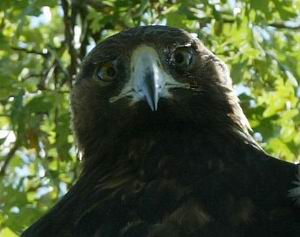Eyes

The daunting gaze of a female golden eagle in Shell Ridge
Don Jedlovec © 2002
Owls have larger eyes for their heads than most other predators since they require more light-gathering power for their crepuscular (dawn and dusk) and nocturnal (night time) activities. Hawks are diurnal (day time) and soar along looking for movement. They can distinguish such motions where everything around the object stays still. Many birds have pigmentation in their eyes that limits the range of colors they can see. This permits then to focus more sharply because the eye doesn’t have to accommodate for chromatic aberration, as does the eye of man. Other birds, such as the black-shouldered kite, hover above an area and then speed down to their prey. Peregrine falcons have been clocked at over 120 miles an hour as they dive – all as a result of their being able to see something that we cannot. During this dive, they never lose sight of their prey. Try this sometime!

Non-binocular vision
Humans, too, have binocular vision.
Jerry Fritzke
June 21, 2003




 Join/Renew
Join/Renew Donate
Donate Volunteer
Volunteer Maps
Maps Newsletter
Newsletter Facebook
Facebook
